TOYOTA PRIUS PRIME 2023 Owners Manual
Manufacturer: TOYOTA, Model Year: 2023, Model line: PRIUS PRIME, Model: TOYOTA PRIUS PRIME 2023Pages: 680, PDF Size: 14.97 MB
Page 321 of 680
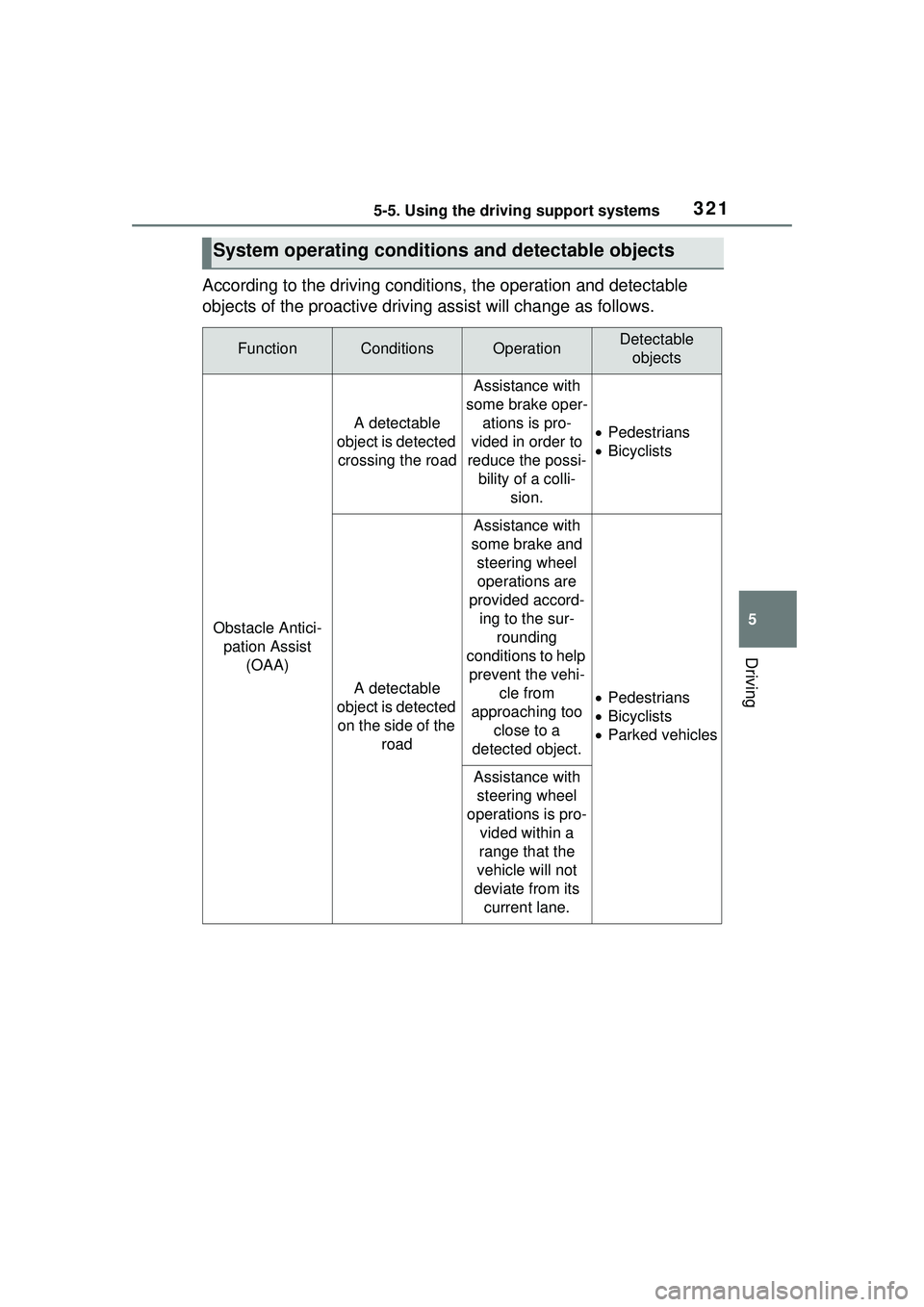
3215-5. Using the driving support systems
5
Driving
According to the driving conditions, the operation and detectable
objects of the proactive driving assist will change as follows.
System operating conditions and detectable objects
FunctionConditionsOperationDetectable
objects
Obstacle Antici-pation Assist (OAA)
A detectable
object is detected crossing the road
Assistance with
some brake oper- ations is pro-
vided in order to
reduce the possi- bility of a colli- sion.
Pedestrians
Bicyclists
A detectable
object is detected on the side of the road
Assistance with
some brake and steering wheel operations are
provided accord- ing to the sur- rounding
conditions to help prevent the vehi- cle from
approaching too close to a
detected object.
Pedestrians
Bicyclists
Parked vehicles
Assistance with
steering wheel
operations is pro- vided within a
range that the
vehicle will not
deviate from its current lane.
Page 322 of 680
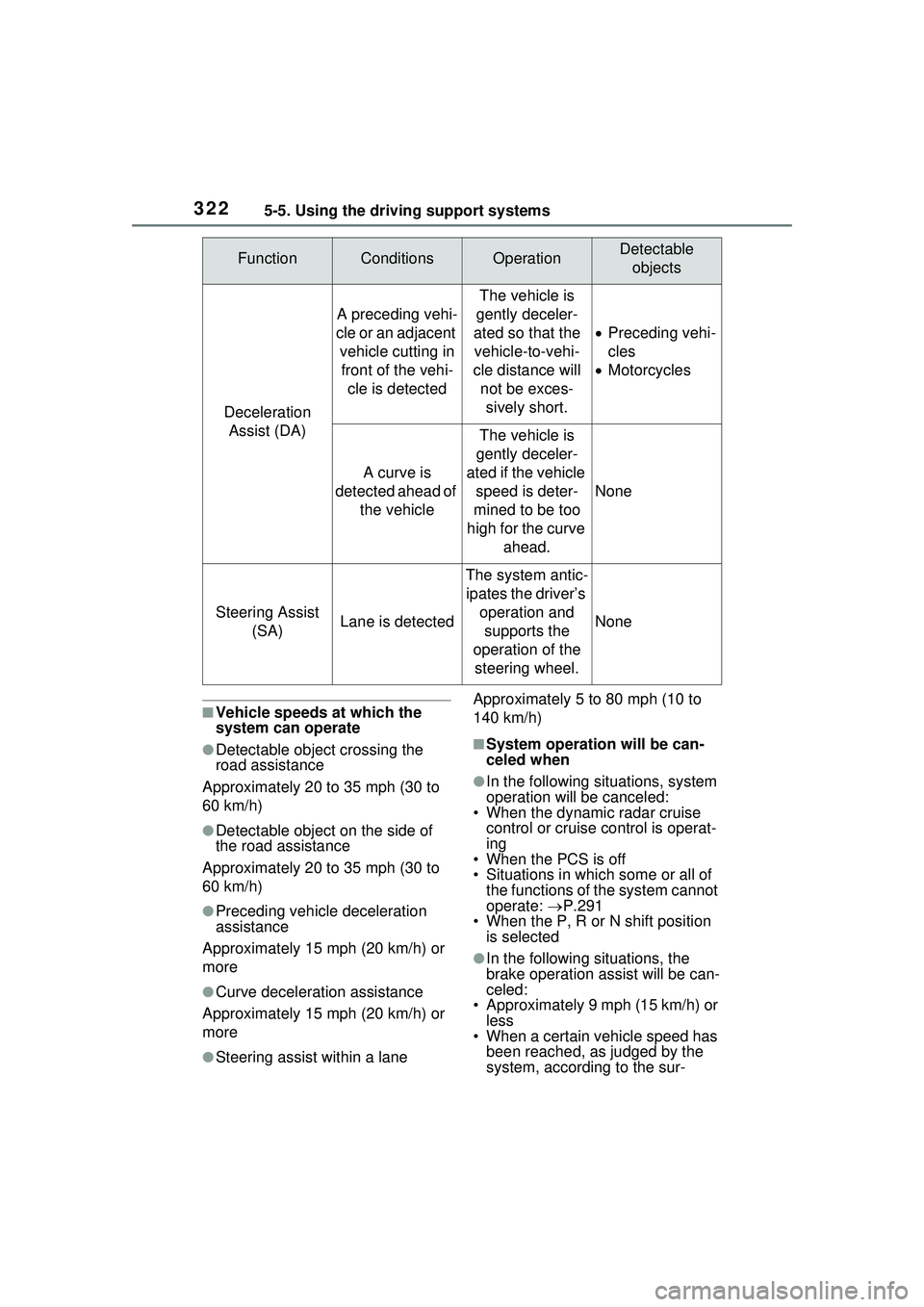
3225-5. Using the driving support systems
■Vehicle speeds at which the
system can operate
●Detectable object crossing the
road assistance
Approximately 20 to 35 mph (30 to
60 km/h)
●Detectable object on the side of
the road assistance
Approximately 20 to 35 mph (30 to
60 km/h)
●Preceding vehicle deceleration
assistance
Approximately 15 mph (20 km/h) or
more
●Curve deceleration assistance
Approximately 15 mph (20 km/h) or
more
●Steering assist within a lane Approximately 5 to 80 mph (10 to
140 km/h)
■System operation will be can-
celed when
●In the following situations, system
operation will be canceled:
• When the dynamic radar cruise control or cruise control is operat-
ing
• When the PCS is off
• Situations in which some or all of the functions of the system cannot
operate: P.291
• When the P, R or N shift position
is selected
●In the following situations, the
brake operation assist will be can-
celed:
• Approximately 9 mph (15 km/h) or less
• When a certain vehicle speed has been reached, as judged by the
system, accordin g to the sur-
Deceleration
Assist (DA)
A preceding vehi-
cle or an adjacent vehicle cutting in front of the vehi- cle is detected
The vehicle is
gently deceler-
ated so that the vehicle-to-vehi-
cle distance will not be exces-sively short.
Preceding vehi-
cles
Motorcycles
A curve is
detected ahead of the vehicle
The vehicle is
gently deceler-
ated if the vehicle speed is deter-
mined to be too
high for the curve ahead.
None
Steering Assist (SA)Lane is detected
The system antic-ipates the driver’s operation and supports the
operation of the steering wheel.
None
FunctionConditionsOperationDetectable objects
Page 323 of 680
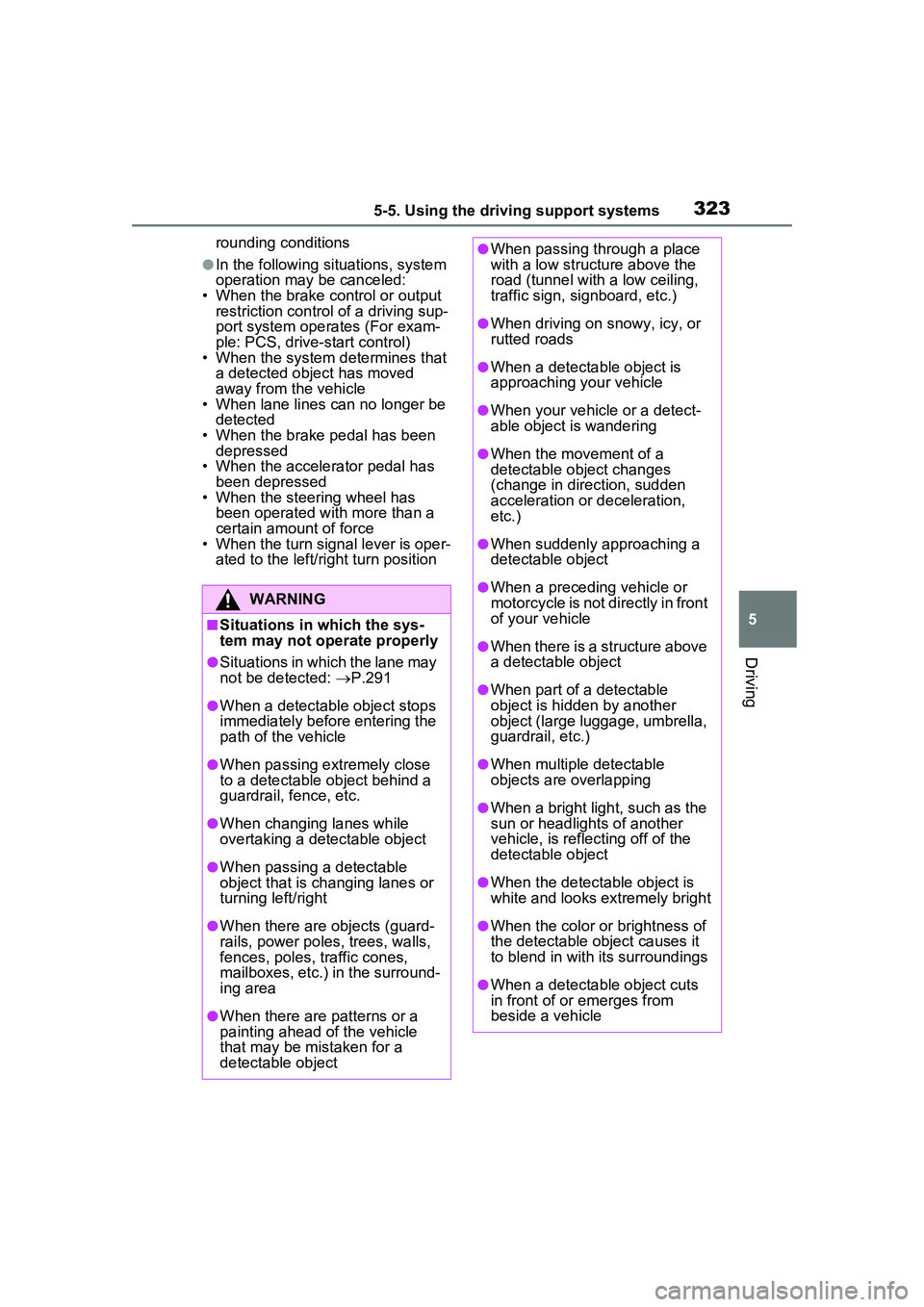
3235-5. Using the driving support systems
5
Driving
rounding conditions
●In the following situations, system
operation may be canceled:
• When the brake control or output restriction control of a driving sup-
port system operates (For exam-
ple: PCS, drive-start control)
• When the system determines that
a detected object has moved
away from the vehicle
• When lane lines can no longer be
detected
• When the brake pedal has been depressed
• When the accelerator pedal has been depressed
• When the steering wheel has
been operated with more than a
certain amount of force
• When the turn signal lever is oper-
ated to the left/right turn position
WARNING
■Situations in which the sys-
tem may not operate properly
●Situations in which the lane may
not be detected: P.291
●When a detectable object stops
immediately before entering the
path of the vehicle
●When passing extremely close
to a detectable object behind a
guardrail, fence, etc.
●When changing lanes while
overtaking a detectable object
●When passing a detectable
object that is changing lanes or
turning left/right
●When there are objects (guard-
rails, power poles, trees, walls,
fences, poles, traffic cones,
mailboxes, etc.) in the surround-
ing area
●When there are patterns or a
painting ahead of the vehicle
that may be mistaken for a
detectable object
●When passing through a place
with a low structure above the
road (tunnel with a low ceiling,
traffic sign, signboard, etc.)
●When driving on snowy, icy, or
rutted roads
●When a detectable object is
approaching your vehicle
●When your vehicle or a detect-
able object is wandering
●When the movement of a
detectable object changes
(change in direction, sudden
acceleration or deceleration,
etc.)
●When suddenly approaching a
detectable object
●When a preceding vehicle or
motorcycle is not directly in front
of your vehicle
●When there is a structure above
a detectable object
●When part of a detectable
object is hidden by another
object (large luggage, umbrella,
guardrail, etc.)
●When multiple detectable
objects are overlapping
●When a bright light, such as the
sun or headlights of another
vehicle, is reflecting off of the
detectable object
●When the detectable object is
white and looks extremely bright
●When the color or brightness of
the detectable object causes it
to blend in with its surroundings
●When a detectable object cuts
in front of or emerges from
beside a vehicle
Page 324 of 680
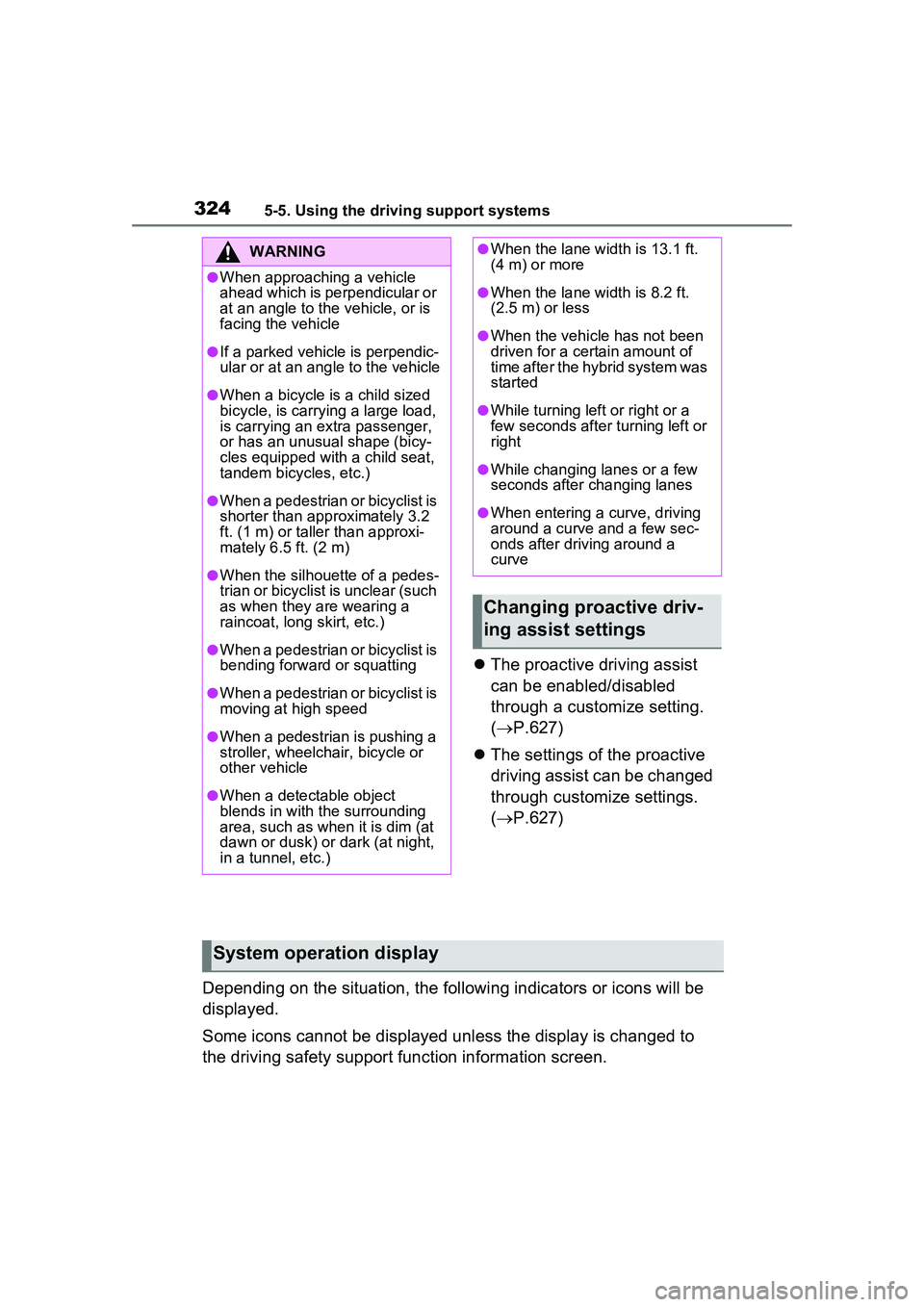
3245-5. Using the driving support systems
The proactive driving assist
can be enabled/disabled
through a customize setting.
( P.627)
The settings of the proactive
driving assist can be changed
through customize settings.
( P.627)
Depending on the situation, the following indicators or icons will be
displayed.
Some icons cannot be displayed unless the display is changed to
the driving safety support function information screen.
WARNING
●When approaching a vehicle
ahead which is perpendicular or
at an angle to the vehicle, or is
facing the vehicle
●If a parked vehicle is perpendic-
ular or at an angle to the vehicle
●When a bicycle is a child sized
bicycle, is carrying a large load,
is carrying an extra passenger,
or has an unusual shape (bicy-
cles equipped with a child seat,
tandem bicycles, etc.)
●When a pedestrian or bicyclist is
shorter than approximately 3.2
ft. (1 m) or taller than approxi-
mately 6.5 ft. (2 m)
●When the silhouette of a pedes-
trian or bicyclist is unclear (such
as when they are wearing a
raincoat, long skirt, etc.)
●When a pedestrian or bicyclist is
bending forward or squatting
●When a pedestrian or bicyclist is
moving at high speed
●When a pedestrian is pushing a
stroller, wheelchair, bicycle or
other vehicle
●When a detectable object
blends in with the surrounding
area, such as when it is dim (at
dawn or dusk) or dark (at night,
in a tunnel, etc.)
●When the lane width is 13.1 ft.
(4 m) or more
●When the lane width is 8.2 ft.
(2.5 m) or less
●When the vehicle has not been
driven for a certain amount of
time after the hybrid system was
started
●While turning left or right or a
few seconds after turning left or
right
●While changing lanes or a few
seconds after changing lanes
●When entering a curve, driving
around a curve and a few sec-
onds after driving around a
curve
Changing proactive driv-
ing assist settings
System operation display
Page 325 of 680
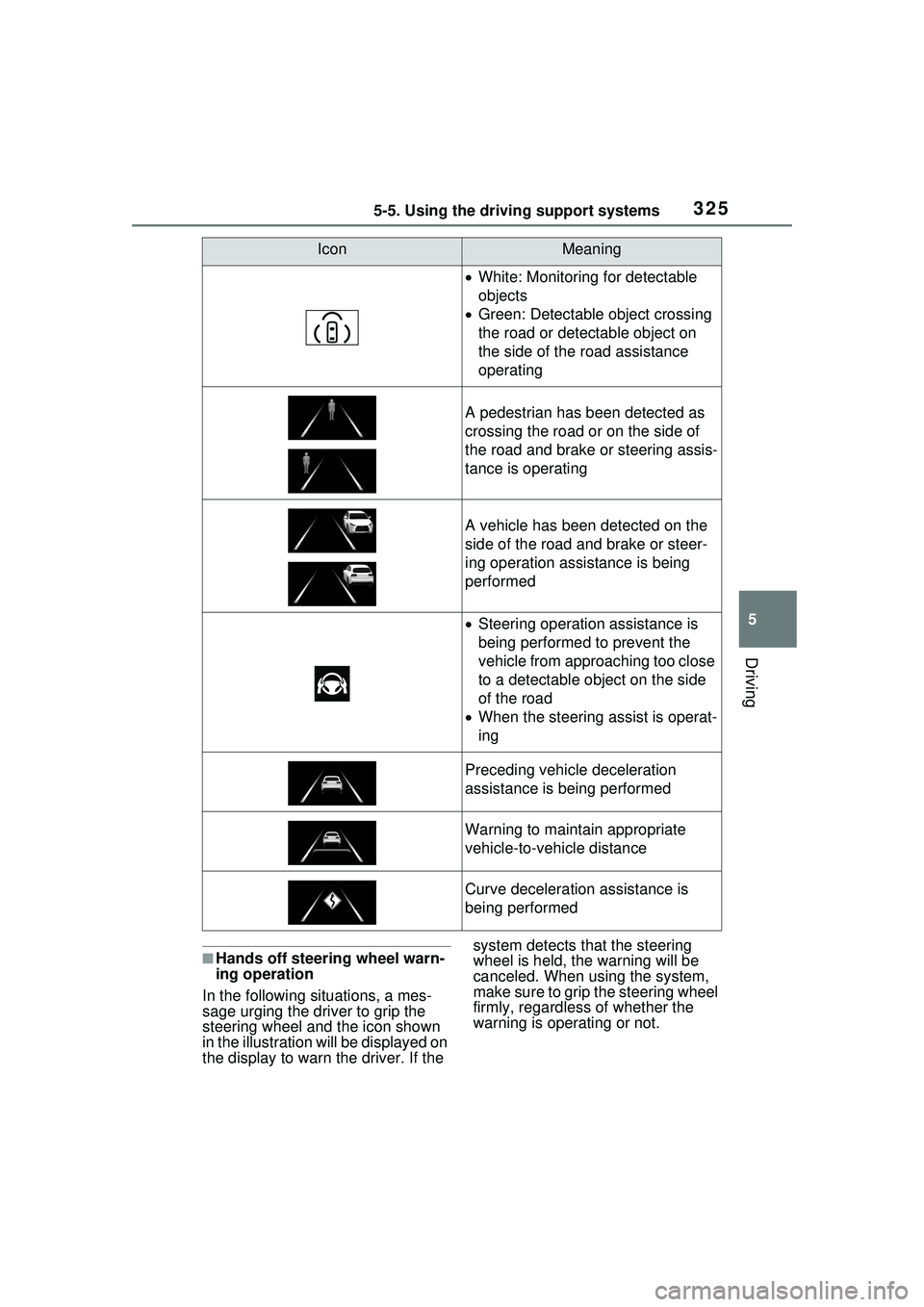
3255-5. Using the driving support systems
5
Driving
■Hands off steering wheel warn-
ing operation
In the following situations, a mes-
sage urging the driver to grip the
steering wheel and the icon shown
in the illustration will be displayed on
the display to warn the driver. If the system detects that the steering
wheel is held, the warning will be
canceled. When using the system,
make sure to grip the steering wheel
firmly, regardless of whether the
warning is operating or not.
IconMeaning
White: Monitoring for detectable
objects
Green: Detectable object crossing
the road or detectable object on
the side of the road assistance
operating
A pedestrian has been detected as
crossing the road or on the side of
the road and brake or steering assis-
tance is operating
A vehicle has been detected on the
side of the road and brake or steer-
ing operation assistance is being
performed
Steering operation assistance is
being performed to prevent the
vehicle from approaching too close
to a detectable object on the side
of the road
When the steering assist is operat-
ing
Preceding vehicle deceleration
assistance is being performed
Warning to maintain appropriate
vehicle-to-vehicle distance
Curve deceleration assistance is
being performed
Page 326 of 680
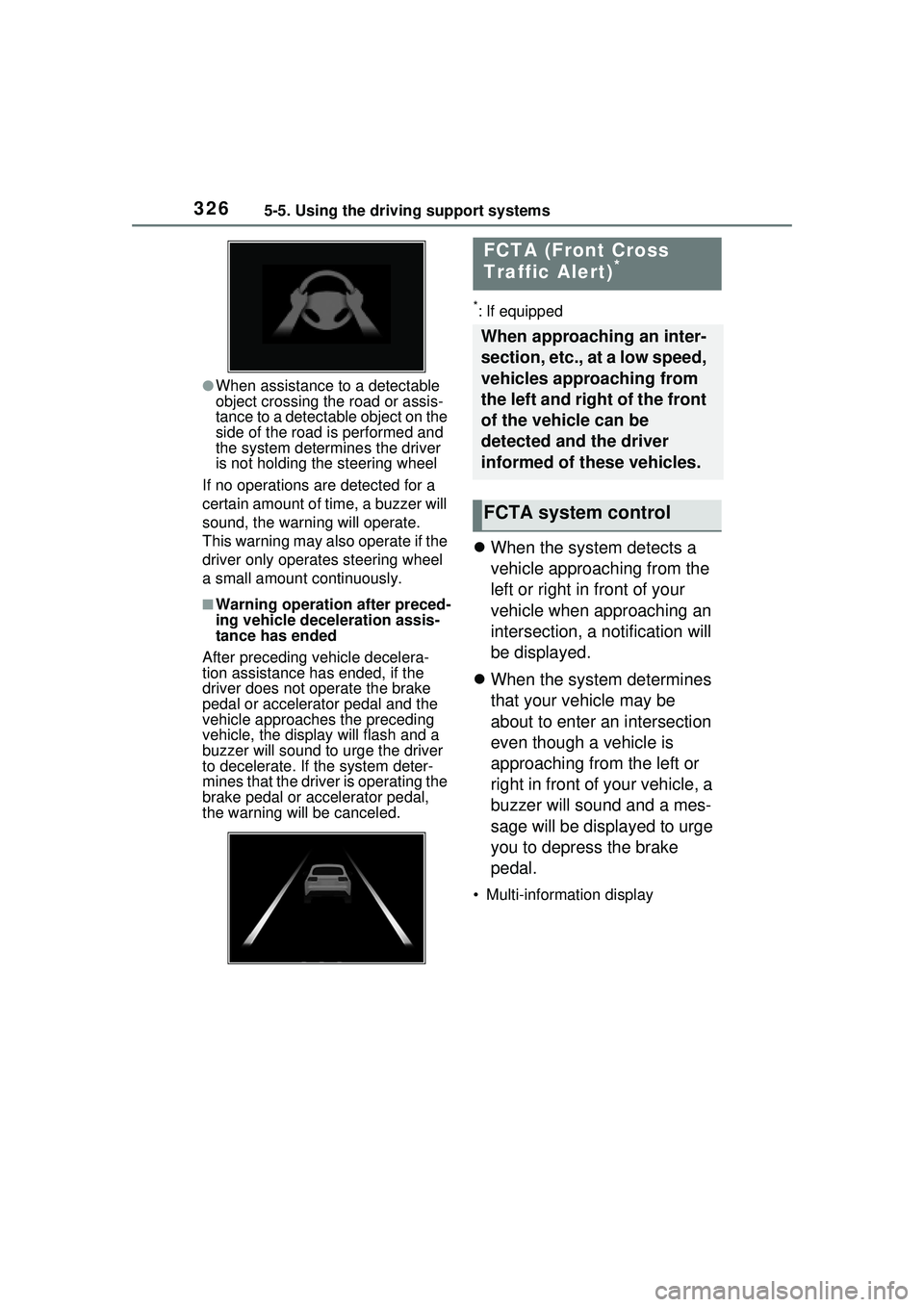
3265-5. Using the driving support systems
●When assistance to a detectable
object crossing the road or assis-
tance to a detectable object on the
side of the road is performed and
the system determines the driver
is not holding the steering wheel
If no operations are detected for a
certain amount of time, a buzzer will
sound, the warning will operate.
This warning may also operate if the
driver only operates steering wheel
a small amount continuously.
■Warning operation after preced-
ing vehicle deceleration assis-
tance has ended
After preceding vehicle decelera-
tion assistance has ended, if the
driver does not operate the brake
pedal or accelerator pedal and the
vehicle approaches the preceding
vehicle, the display will flash and a
buzzer will sound to urge the driver
to decelerate. If the system deter-
mines that the driver is operating the
brake pedal or accelerator pedal,
the warning will be canceled.
*: If equipped
When the system detects a
vehicle approaching from the
left or right in front of your
vehicle when approaching an
intersection, a notification will
be displayed.
When the system determines
that your vehicle may be
about to enter an intersection
even though a vehicle is
approaching from the left or
right in front of your vehicle, a
buzzer will sound and a mes-
sage will be displayed to urge
you to depress the brake
pedal.
• Multi-information display
FCTA (Front Cross
Traffic Alert)*
When approaching an inter-
section, etc., at a low speed,
vehicles approaching from
the left and right of the front
of the vehicle can be
detected and the driver
informed of these vehicles.
FCTA system control
Page 327 of 680
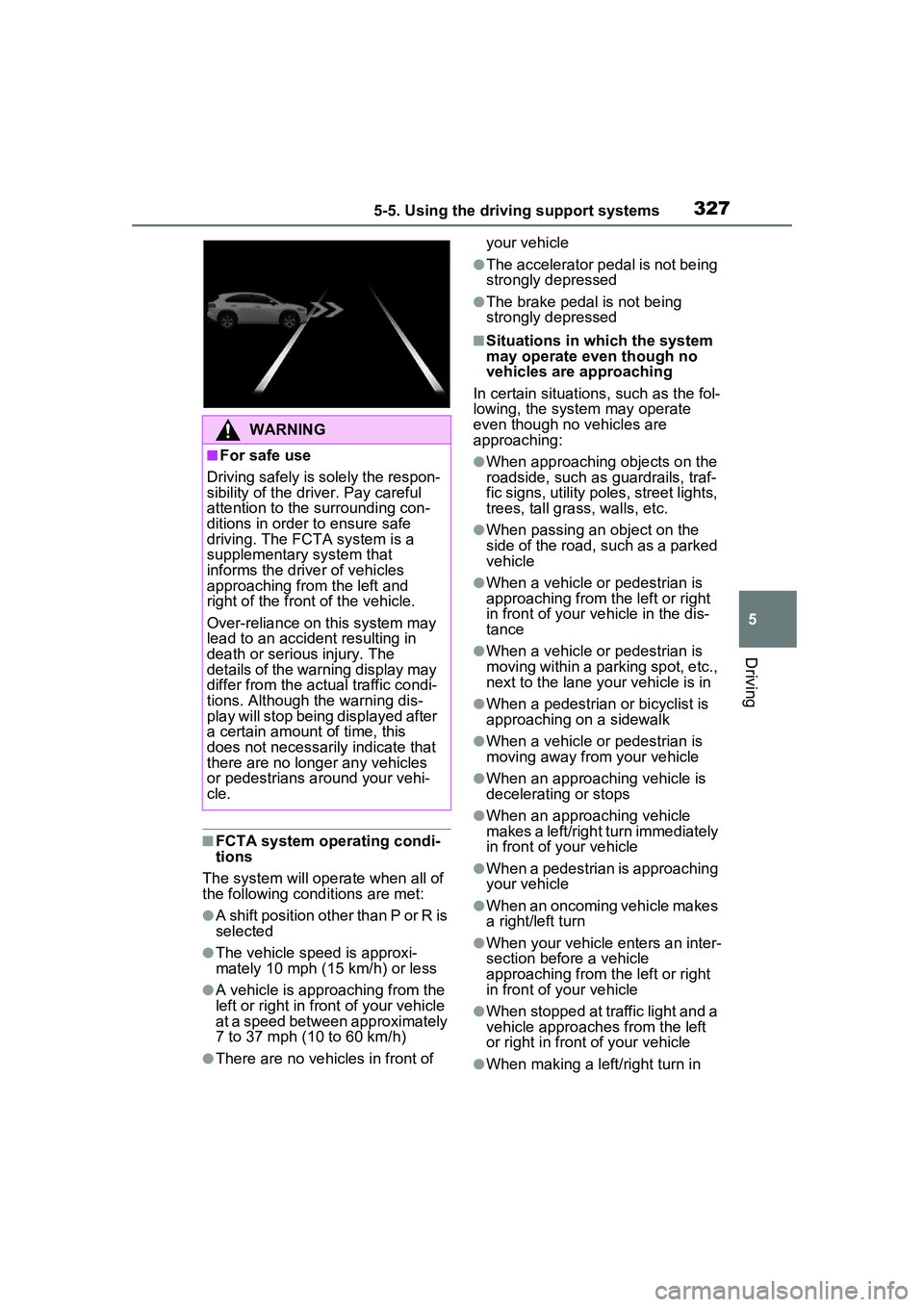
3275-5. Using the driving support systems
5
Driving
■FCTA system operating condi-
tions
The system will operate when all of
the following conditions are met:
●A shift position other than P or R is
selected
●The vehicle speed is approxi-
mately 10 mph (15 km/h) or less
●A vehicle is approaching from the
left or right in front of your vehicle
at a speed between approximately
7 to 37 mph (10 to 60 km/h)
●There are no vehicles in front of your vehicle
●The accelerator pedal is not being
strongly depressed
●The brake pedal is not being
strongly depressed
■Situations in which the system
may operate even though no
vehicles are approaching
In certain situations, such as the fol-
lowing, the system may operate
even though no vehicles are
approaching:
●When approaching objects on the
roadside, such as guardrails, traf-
fic signs, utility poles, street lights,
trees, tall grass, walls, etc.
●When passing an object on the
side of the road, such as a parked
vehicle
●When a vehicle or pedestrian is
approaching from the left or right
in front of your vehicle in the dis-
tance
●When a vehicle or pedestrian is
moving within a parking spot, etc.,
next to the lane your vehicle is in
●When a pedestrian or bicyclist is
approaching on a sidewalk
●When a vehicle or pedestrian is
moving away from your vehicle
●When an approaching vehicle is
decelerating or stops
●When an approaching vehicle
makes a left/right turn immediately
in front of your vehicle
●When a pedestrian is approaching
your vehicle
●When an oncoming vehicle makes
a right/left turn
●When your vehicle enters an inter-
section before a vehicle
approaching from the left or right
in front of your vehicle
●When stopped at traffic light and a
vehicle approaches from the left
or right in front of your vehicle
●When making a left/right turn in
WARNING
■For safe use
Driving safely is solely the respon-
sibility of the driver. Pay careful
attention to the surrounding con-
ditions in order to ensure safe
driving. The FCTA system is a
supplementary system that
informs the driver of vehicles
approaching from the left and
right of the front of the vehicle.
Over-reliance on this system may
lead to an accident resulting in
death or serious injury. The
details of the warning display may
differ from the actual traffic condi-
tions. Although the warning dis-
play will stop being displayed after
a certain amount of time, this
does not necessarily indicate that
there are no longer any vehicles
or pedestrians around your vehi-
cle.
Page 328 of 680
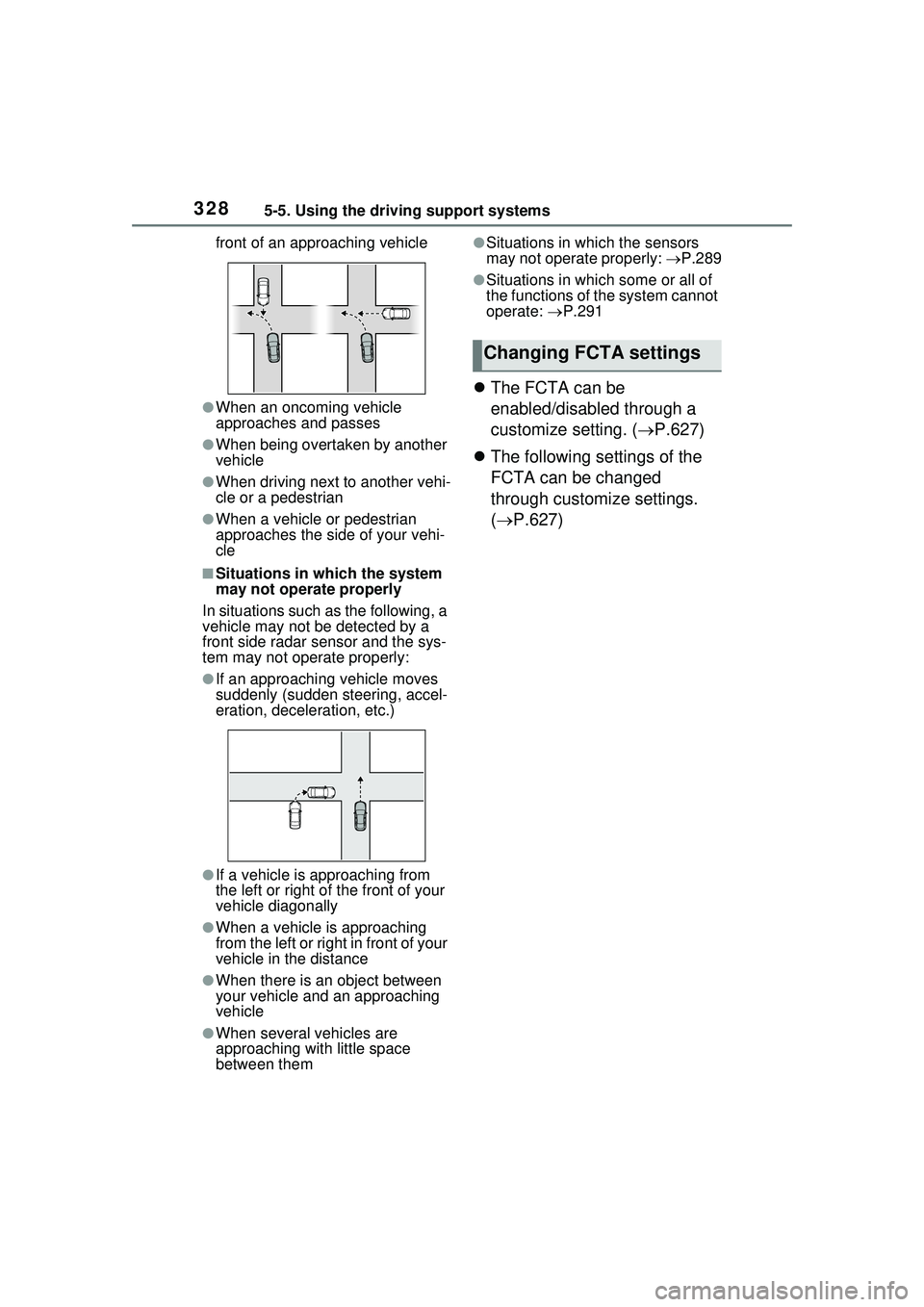
3285-5. Using the driving support systems
front of an approaching vehicle
●When an oncoming vehicle
approaches and passes
●When being overtaken by another
vehicle
●When driving next to another vehi-
cle or a pedestrian
●When a vehicle or pedestrian
approaches the side of your vehi-
cle
■Situations in which the system
may not operate properly
In situations such as the following, a
vehicle may not be detected by a
front side radar sensor and the sys-
tem may not operate properly:
●If an approaching vehicle moves
suddenly (sudden steering, accel-
eration, deceleration, etc.)
●If a vehicle is approaching from
the left or right of the front of your
vehicle diagonally
●When a vehicle is approaching
from the left or right in front of your
vehicle in the distance
●When there is an object between
your vehicle and an approaching
vehicle
●When several vehicles are
approaching with little space
between them
●Situations in which the sensors
may not operate properly: P.289
●Situations in which some or all of
the functions of the system cannot
operate: P.291
The FCTA can be
enabled/disabled through a
customize setting. ( P.627)
The following settings of the
FCTA can be changed
through customize settings.
( P.627)
Changing FCTA settings
Page 329 of 680
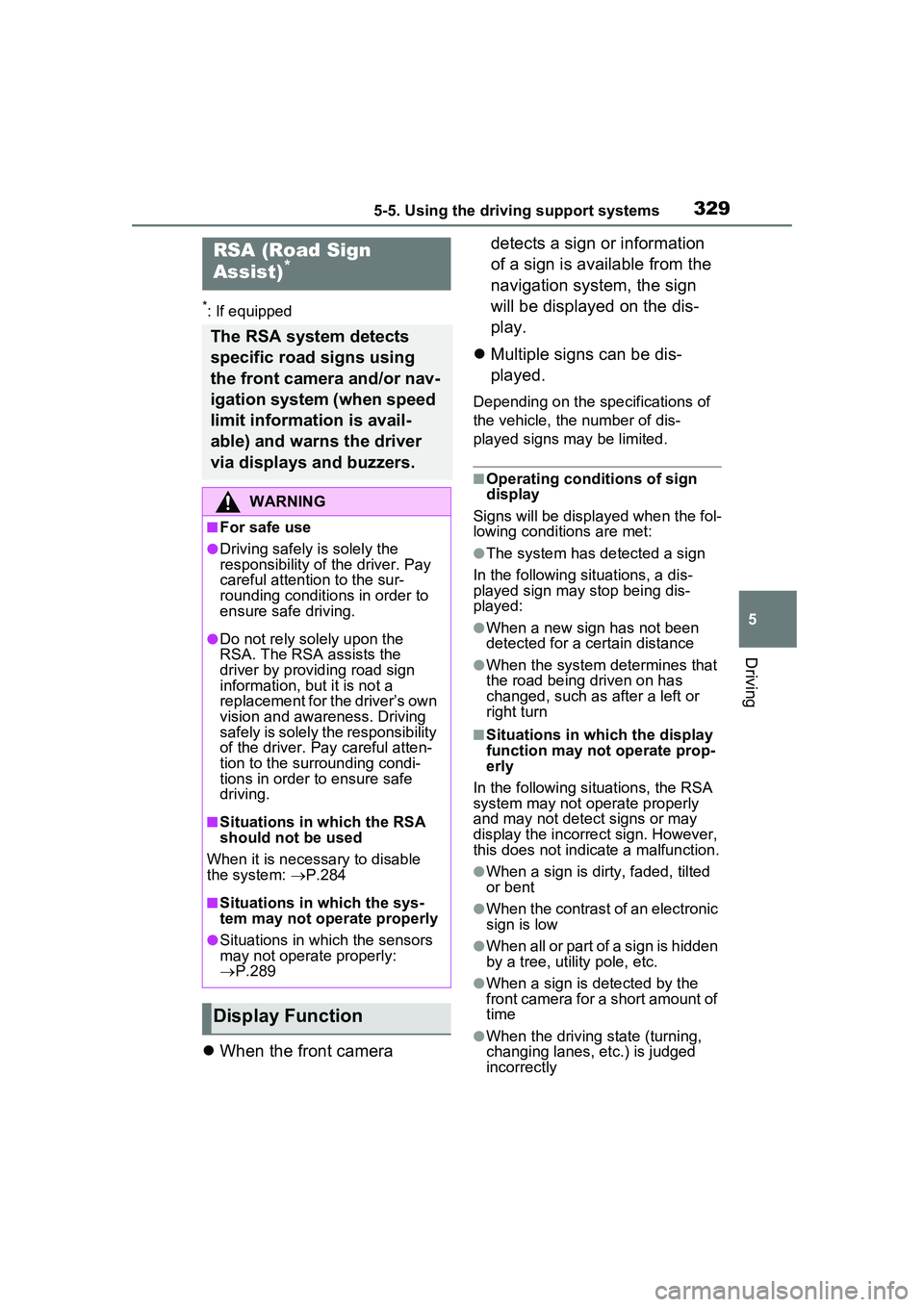
3295-5. Using the driving support systems
5
Driving
*: If equipped
When the front camera detects a sign or information
of a sign is available from the
navigation system, the sign
will be displayed on the dis-
play.
Multiple signs can be dis-
played.
Depending on the specifications of
the vehicle, the number of dis-
played signs may be limited.
■Operating conditions of sign
display
Signs will be displayed when the fol-
lowing conditions are met:
●The system has detected a sign
In the following situations, a dis-
played sign may stop being dis-
played:
●When a new sign has not been
detected for a certain distance
●When the system determines that
the road being driven on has
changed, such as after a left or
right turn
■Situations in which the display
function may not operate prop-
erly
In the following situations, the RSA
system may not operate properly
and may not detect signs or may
display the incorrect sign. However,
this does not indicate a malfunction.
●When a sign is dirty, faded, tilted
or bent
●When the contrast of an electronic
sign is low
●When all or part of a sign is hidden
by a tree, utility pole, etc.
●When a sign is detected by the
front camera for a short amount of
time
●When the driving state (turning,
changing lanes, etc.) is judged
incorrectly
RSA (Road Sign
Assist)*
The RSA system detects
specific road signs using
the front camera and/or nav-
igation system (when speed
limit information is avail-
able) and warns the driver
via displays and buzzers.
WARNING
■For safe use
●Driving safely is solely the
responsibility of the driver. Pay
careful attention to the sur-
rounding conditions in order to
ensure safe driving.
●Do not rely solely upon the
RSA. The RSA assists the
driver by providing road sign
information, but it is not a
replacement for the driver’s own
vision and awareness. Driving
safely is solely the responsibility
of the driver. Pay careful atten-
tion to the surrounding condi-
tions in order to ensure safe
driving.
■Situations in which the RSA
should not be used
When it is necessary to disable
the system: P.284
■Situations in which the sys-
tem may not operate properly
●Situations in which the sensors
may not operate properly:
P.289
Display Function
Page 330 of 680

3305-5. Using the driving support systems
●When a sign is immediately after a
freeway junction or in an adjacent
lane just before merging
●When stickers are attached to the
rear of a preceding vehicle
●When a sign similar to a system
compatible sign is detected as a
system compatible sign
●When a speed limit sign for a
frontage road is within detection
range of the front camera
●When driving around a round-
about
●When a sign intended for trucks,
etc. is detected
●When the navigation system map
data is out of date
●When the navigation system can-
not be used
In this case, the speed limit signs
displayed on the multi-information
display and navigation system dis-
play may differ.
In the following situations, the
RSA system will output a warn-
ing to notify the driver.
If the vehicle speed exceeds
the speed warning threshold
of the speed limit sign dis-
played on the display, the
sign display will be empha-
sized and a buzzer will sound.
When the RSA system
detects a do not enter sign
and determines that the vehi-
cle has entered a no-entry
area, the do not enter sign
displayed on the display will
flash and a buzzer will sound.
■Operating conditions of the
notification functions
●Excess speed notification function
This function will operate when the
following condition is met:
• A speed limit road sign is recog- nized by the system.
●No entry notification function
This function will operate when all of
the following conditions are met:
• More than one no entry road signs are recognized by the system
simultaneously.
• The vehicle is passing between no
entry road signs recognized by the
system.
The following types of road
signs can be displayed.
However, non-standard or recently
introduced traffic signs may not be
displayed.
Notification function
Types of road signs sup-
ported
Speed limit
Do Not Enter
No U-turn
No Turn On Red